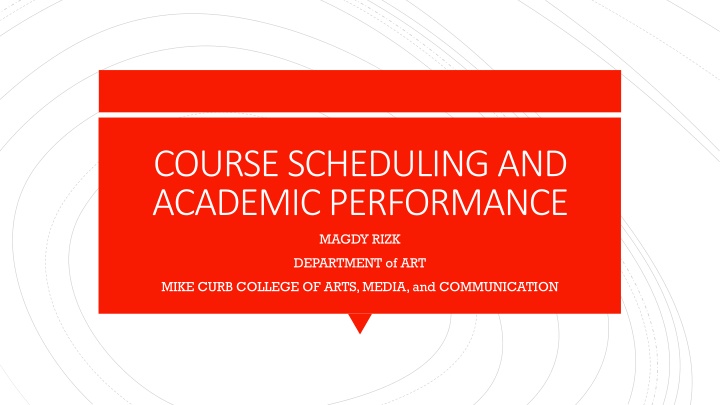
Impact of Time on Student Academic Performance in Art Department
Explore how time and day affect student academic performance in the Department of Art at the Mike Curb College of Arts, Media, and Communication. The study analyzes raw data on student performance, identifies trends in different course schedules, and suggests adjustments to improve passing grades throughout the day.
Download Presentation

Please find below an Image/Link to download the presentation.
The content on the website is provided AS IS for your information and personal use only. It may not be sold, licensed, or shared on other websites without obtaining consent from the author. If you encounter any issues during the download, it is possible that the publisher has removed the file from their server.
You are allowed to download the files provided on this website for personal or commercial use, subject to the condition that they are used lawfully. All files are the property of their respective owners.
The content on the website is provided AS IS for your information and personal use only. It may not be sold, licensed, or shared on other websites without obtaining consent from the author.
E N D
Presentation Transcript
COURSE SCHEDULING AND ACADEMIC PERFORMANCE MAGDY RIZK DEPARTMENT of ART MIKE CURB COLLEGE OF ARTS, MEDIA, and COMMUNICATION
Does time and day affect student academic performance? Guiding Questions Our student population is well known to have various adverse circumstances that may affect their academic performance. Jobs, family responsibilities, travel distance and time, are some of these inhibitors.
Raw data containing student academic performance for all courses in the MCAMC, from 2012 -2017. Initially, data was separated into MW, TR, S, F, M, T, W, R course data sets. The above data was then separated into upper and lower division sets. Overview of Data Times of day with the highest N for each day(s) were designated. To find trends, evening course were also included in these designations to find movement throughout the day(s). The extracted data was then charted. (appendix 1A, 1B)
MW courses: Lower division: Little variance in passing grades through the day. DFUs shows a downward trend through the day. Upper division: Similar to above. TR courses: Lower division: Little variance in passing grades through the day. DFUs shows a upward trend through the day. Upper division: Little variance in passing grades through the day. DFUs shows a downward trend through the day. F courses: Lower division: Upward trend in passing grades through the day. DFUs shows a downward trend through the day. Upper division: Little variance in passing grades through the day. DFUs shows an upward trend through the day. Findings S courses: Lower division: Little variance in passing grades through the day. DFUs shows little variance through the day. Upper division: Little variance in passing grades through the day. DFUs shows an upward trend through the day. M, T, W, R courses: Lower division: Dip in passing grades mid to late morning. DFUs shows little downward trend through the day except for M. Upper division: Little variance in passing grades through the day. DFUs shows a downward trend through the day.
There are more downward trends of DFUs in most day(s) configurations. Consider further scrutiny of pedagogy and grading policies for earlier courses. This may increase passing grades for this segment of the day(s). Concluding thoughts This study needs a break out for each department in the MCCAMC. In addition, further study to differentiate student performance in lecture courses versus studio/performance courses should be considered.
